Chinese Journal of Tissue Engineering Research ›› 2019, Vol. 23 ›› Issue (16): 2553-2559.doi: 10.3969/j.issn.2095-4344.1213
Previous Articles Next Articles
Application of finite element technology in lumbar degenerative diseases
Sun Ke1, Yang Xuejun2
- 1Inner Mongolia Medical University, Hohhot 010000, Inner Mongolia Autonomous Region, China; 2Department of Thoracolumbar Surgery, the Second Affiliated Hospital of Inner Mongolia Medical University, Hohhot 010000, Inner Mongolia Autonomous Region, China
-
Online:2019-06-08Published:2019-06-08 -
Contact:Yang Xuejun, Master, Chief physician, Department of Thoracolumbar Surgery, the Second Affiliated Hospital of Inner Mongolia Medical University, Hohhot 010000, Inner Mongolia Autonomous Region, China -
About author:Sun Ke, Master candidate, Inner Mongolia Medical University, Hohhot 010000, Inner Mongolia Autonomous Region, China -
Supported by:the Project of Science and Technology Department of Inner Mongolia Autonomous Region, No. 02015013 (to YXJ)
CLC Number:
Cite this article
Sun Ke, Yang Xuejun. Application of finite element technology in lumbar degenerative diseases[J]. Chinese Journal of Tissue Engineering Research, 2019, 23(16): 2553-2559.
share this article
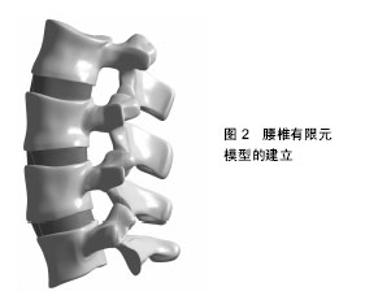
2.1 有限元方法的概念 自1974年Belytschko等[1]首次将有限元法应用于脊柱生物力学领域后,科研人员使用这种方法研究脊柱生物力学已近半个世纪。 通常一个复杂的弹性物体可以被看成是由无限个质点组成的连续体,因其有无限的自由度,因此不可能对其进行分析并且求解。而在有限元方法诞生后,可以通过在计算机中建立一个与真实结构等价的模型,并赋予模型真实的弹性模量再将其离散为有限个单元组成的连续集合体,这些集合体只能在有限节点进行交接,这样就使全部的节点具有有限的自由度,使求解变为可能,这种将无数个分散单元还原成可用线性代数描述的真实连续结构,并且通过运算而得出所需力学数据的方法即为有限元法,又称为有限元素法[2]。有限元法是凭借着位移法的思考方式,将能量转换作为基础,利用矩阵代数形式进行表达的一种方法[3]。 因有限元技术可以通过改变有限单元、节点、自由度等条件,运算并得出想要的物理学参数的特点,它得到了越来越多的认同并且应用于各个领域。有限元法的种种优势,弥补了传统力学实验的不足[4],明显提高了对物理学参数计算的效率,加快了医学生物力学技术应用的发展。尤其在医学骨科领域的研究中,可以通过有限元的方法将各种复杂边界的几何形状进行处理,并且可以有效解决各类复杂的材料及其属性,所以在对人体骨骼系统进行生物力学分析中有着得天独厚的优势。 2.2 有限元方法在腰椎应用的原理 2.2.1 腰椎生物力学研究中常用的有限元软件 目前常用于进行腰椎生物力学分析的有限元软件主要有MSCNASTRAN、ANSYS、ABAQUS、MARC等[5-6],这些软件的基本原理、计算方法基本相同,但是这些软件都有各自的特点。目前进行有限元分析时基本采用格式为计算机辅助设计的数据图形软件。在这些软件中,ABAQUS进入中国市场较晚,且与计算机辅助设计的接口通用性不如MSCNASTRAN和ANSYS效果好,在计算腰椎模型复杂的曲面时,若将计算机辅助设计导入ABAQUS,模型往往会失真,需要多次对模型进行几何修补,有许多不便之处。MARC软件在计算高度非线性问题时更具有优势,尤其是模拟高分子材料时可以取得较为满意的结果,如橡胶材料的非线性分析,但是在腰椎生物力学分析中使用较少[7]。相比较而言,MSCNASTRAN及ANSYS软件与计算机辅助设计兼容性较好,输出数据也稳定,因此 MSCNASTRAN和ANSYS使用率较高,且功能齐全,被人们广泛接受[8]。 2.2.2 应用有限元技术建立腰椎模型的方法 基于有限元方法的理论,腰椎有限元模型的建立基本相同,但是获取实际物理数据的方法则有些许不同,常见的方法有: (1)三维坐标仪建模法:利用三维坐标仪得到腰椎的真实空间坐标,然后输入计算机进行建模,这种方法获得的数据真实准确,但是相当繁琐,对于腰椎这种不规则的几何体而言,会大大增加计算量,因此常用于形态较规则的物体。 (2)几何建模:根据腰椎的几何形状以及尺寸构建模型,这种方法较简单但同样适用于形态规则的物体[9]。 (3)图像建模:利用 CT、MRI等方法获取腰椎的影像学资料,通过MIMICS、GEOMAGIC以及SOLIDWORK等相关的软件对图像进行处理并建立有限元模型。这种方法更适用于腰椎等不规则物体模型的建立,随着技术的进步,CT以及MRI等机器采集厚度的精细化,通过这种方法得出的腰椎有限元模型可以得到较高的保真效果,计算得出的生物力学参数更符合实际。目前,多数腰椎生物力学的研究是通过此方法建模[10]。 2.2.3 有限元技术在腰椎生物力学研究中的应用 (1)有限元技术在腰椎生物力学应用中的优势:人体中,腰椎不仅承担支持躯干的质量而且需要完成不同形式的运动功能,因此无论腰椎的正常状态还是病理状态的生物力学的研究一直是学者关注的焦点。Du 等[11]以及Rohlmann等[12]建立有限元模型并对模型进行受力分析,将所得结果与文献报道的真实尸体标本生物力学数据对比,证实了其有限元模型的有效性。与传统的使用尸体标本进行生物力学分析相比,有限元模型在几何形态上不仅十分接近真实标本模型且有以下优点: a、传统的尸体标本制备时间长,成本高,尸体标本生物力学实验的条件要求严格,需要大量脊柱尸体标本,存在病毒感染风险[13],并且可能会涉及到伦理问题,而有限元模型获取相对便捷且用时较短,通常先获取研究目标的影像学数据,将影像学数据导入相应的软件中建立模型及分布模板,赋予有限元模型真实弹性模量并计算,即可得出相应结果。 b、可以根据需求建立多个有限元模型,在实验过程中,可以随时对模型进行修正并且重复实验,通过模拟腰椎的病理状态、手术方式等,得到相应的生物力学参数,有限元模型因其可重复性高、实验成本低的优点,被越来越多的临床医师关注[14]。 c、在有限元模型建立中,其属性都是根据真实材料人为赋予,所以模型的材料属性比较能够准确的反映各组织的力学性能;减少了各方面人为因素的干扰,降低了实验数据由于受到不同实验时间、条件以及方法的限制约束[13],应用有限元模型对患者腰椎进行替代,并导入计算机进行力学研究,有限元法得出的生物力学参数可以由图表显示,不仅可以得到椎体、间盘等应力分布,还可以直观地看到不同活动状态时脊柱的稳定性,使得到的生物力学数据更有说服力[15]。 d、有限元技术在模拟手术、预判及研究手术效果方面有显著优势,在传统诊治过程中,医师并不能很好的判断所选术式是否适用于患者及其愈后如何,传统的生物力学分析往往要受到伦理道德、个体差异的制约。有限元技术的出现及飞速的发展,为此种难题提供了解决方案[4]。 如今,有限元技术因其自身的种种优点被脊柱外科医师广泛接受,已被应用于各种临床研究,针对不同腰椎疾患进行针对性建模并分析,为医师制定个性化的治疗方案提供生物力学依据。 (2)有限元技术在腰椎生物力学应用中的进展:1974年在Belytschko 等首次将有限元技术运用于脊柱生物力学的研究之后,有限元模型逐渐成为现代脊柱生物力学研究的重要方法之一,可以应用有限元模型模拟腰椎在各种运动、负载下的状态,并根据需求计算各种状态下腰椎各个部位的应力、应变分布、稳定性等等,如El-Rich等[16]以及Little等[17]分别利用有限元技术分析腰椎在前屈、后伸、左右旋转下椎体及间盘受力;而Yin等[18]、Kim等[19]则通过有限元技术对腰椎后方肌肉进行了分析。有限元技术不仅可以通过有限元原理模拟正常状态下的腰椎模型,甚至可以模拟腰椎的各种病理状态和手术的方法,探究其力学原理、损伤机制以及治疗效果。了解相关位置的力学参数并且评估不同术式治疗的作用,通过得到的有限元参数可以帮助临床医生更好的选择手术方法进行改善[20],为腰椎生物力学方面的研究提供理论基础。三维有限元分析法在生物力学中的应用研究极大地拓展了人们对腰椎生物力学的认知,对于因腰椎生物力学产生的一些疾病,也有了更全面且深入的认识。 2.3 有限元方法在腰椎退行性疾患中的应用 随着中国人口老龄化的加剧,腰椎退行性疾病日益增多,这类疾患中多由于椎间盘退变导致的神经根受到压迫或刺激产生明显的腰痛合并下肢麻木、疼痛等症状,往往影响患者的生活质量,许多患者在保守治疗无效或合并神经根病损的情况下需要手术治疗。但是无论腰椎发生退行性改变还是采用不同类型的手术都会对腰椎局部甚至整个脊柱的生物力学稳定性产生不同程度的影响。 2.3.1 有限元在腰椎退行性疾患中的应用 (1)腰椎退行性疾患中椎体及间盘的生物力学研究:很多学者利用有限元技术对腰椎退行性疾患中椎体及间盘的生物力学进行分析,见图2。El-Rich等[16]研究表明,腰椎在前屈时椎体所受应力集中于腰椎椎弓根区域的上面。腰椎在进行后伸时,最大应力分布于椎体及椎弓根区域的下面。椎间盘应力在前屈时增大。这为日常生活中预防腰椎退变并进行正确的姿势调整提供了理论依据。闫家智等[21]研究表明,在对腰椎施加轴向力时,腰椎纤维环后部应力较高,最大应力集中于髓核和终板的中央。而黄菊英等[22]建立了腰椎L4-5节段的正常模型和L4-5节段腰椎间盘突出的2种模型。利用有限元技术分析2种模型在不同工况下椎间盘的生物力学变化。结果显示腰椎间盘的模型其应力分布改变主要集中于纤维环的后外侧;相同的的载荷条件下,腰椎间盘突出模型椎间盘突出的形变量比正常模型的椎间盘大。Little等[17]发现间椎间盘髓核退变对腰椎的影响远远大于纤维环退变对对腰椎的影响,纤维环的退变对腰椎的生物力学的影响较小,完全退变的椎间盘与健康的椎间盘生物力学参数明显不同,随着椎间盘髓核的变性椎间盘的弹性逐渐降低。Dou等[23]利用有限元技术对髓核摘除术进行分析,发现髓核摘除术后腰椎椎体以及小关节受力均有增加,得出髓核摘除后加速了腰椎退变的结论。在终板的研究方面,Salo等[24]研究表明,在进行腰椎融合手术时切除软骨并植入同种异体骨将会增大剩余终板的应力,在其两者接触的区域里,会产生一个应力的峰值。另一方面,若完全切除终板及软骨,将会使相邻椎体内的应力显著增加,作者认为软骨及终板对腰椎稳定性起着重要作用。Costi等[25]通过有限元研究发现,椎体主要的应力受椎间盘退变的影响不显著,邻近椎间盘-终板边界的皮质骨保持相对稳定的状态,主要的结构变化可能发生在相邻椎体的骨小梁内。通过有限元技术,可以更方便直观的对腰椎退行性疾患进行研究,这无疑明显加深了临床医师对该类疾病生物力学的认知。"
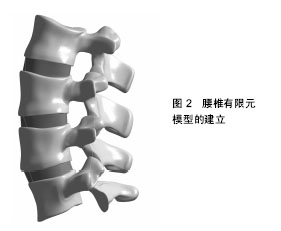
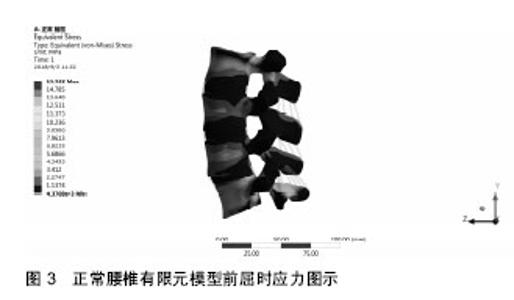
(2)腰椎退行性疾患中腰椎后方结构的生物力学研究:精准模型的建立必然离不开后方韧带及肌肉的支持,腰椎后方结构对腰椎稳定性起至关重要作用,见图3。现如今,腰椎有限元模型不仅能模拟椎体、间盘,甚至可以建立小关节模型以及通过将多根韧带、肌肉定义为缆式单元,建立韧带、肌肉束并赋予相应力学参数去进行模拟[26]。很多学者通过对腰椎退行性疾患进行模拟,发现在病理状态下腰椎不同结构的应力及改变。在腰椎肌肉模拟方面,Yin等[18]建立带有肌肉的腰椎有限元模型,并得出了健康脊柱与患有腰背部疼痛患者的脊柱肌肉活动存在显著差异。Kim等[19]通过建立腰椎退变以及肌肉模型证明了腰椎间盘退变会增加腰椎浅表部位肌肉的应力,而深部肌肉的活化性却会降低。有学者对腰椎后路小关节及韧带复合体进行了研究,如张美超等[27]建立了腰椎L4-5阶段的有限元模型,分析小关节在不同状态下生物力学的特性,他们发现小关节在椎体的轴向旋转运动状态下具有特别明显的抗旋转作用。Cahill等[28]在利用有限元分析脊柱术后脊柱交界性后凸时发现,棘突和棘上韧带复合体可预防近端脊柱交界性后凸的发生。由此可见,腰椎后方的韧带、肌肉等对腰椎的稳定性起着至关重要的作用,在进行腰椎手术时,尽量减少对腰椎后路结构的破坏是必要的。"
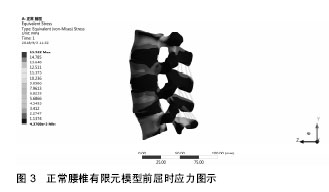
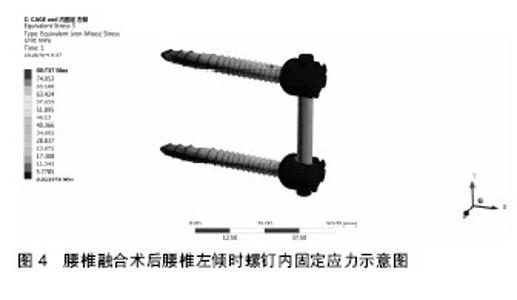
2.3.2 有限元在腰椎不同融合手术方式生物力学方面研究的应用 通过有限元技术可以建立临床上治疗腰椎退行性疾患不同术式的模型,通过导入数据,得出相关力学参数,从而比较不同术式对疾病的治疗效果,为患者制定个性化治疗方案。对于腰椎融合术后的患者,作者更加关注融合后腰椎的稳定性以及对邻近节段的影响。 (1)腰椎融合术后腰椎稳定性的生物力学研究:Silve等[29]利用有限元技术研究得出,在置入椎弓根螺钉时皮质骨提供10%的强度,在对椎体施加高压力载荷时,终板中下方的松质骨会发生骨折,椎体的强度会显著下降,椎体内的压力则会随之升高。而有研究通过有限元对传统后路腰椎椎间融合术以及经椎间孔椎间融合术式进行对比,发现2种手术方法中,融合节段远端椎体的上终板应力大于近端椎体下终板的应力,因此融合器往往沉降于远端椎体的下终板,腰椎后柱结构中的椎板、棘突及韧带复合体在腰椎稳定性方面起着比单侧关节突更重要的作用。因此经椎间孔椎间融合术的稳定性优于后路腰椎椎间融合术。陶勇等[10]通过有限元技术对后路腰椎椎间融合术后应力进行了详细的分析,他们发现在进行后路腰椎椎间融合术式切除椎板后,腰椎椎体的局部受力会增加,主要集中于脊柱椎板以及后方的椎弓根和小关节处,且若不做内固定,腰椎活动度增大,稳定性下降,若增加相应的内固定系统,虽然腰椎活动度减小,稳定性增加,但此时应力将会相对集中于椎弓根螺钉,导致椎弓根螺钉断裂的风险明显增加。Salo等[24]研究表明,在进行刚性内固定时,相邻终板的应力受到的影响很小,使用内固定系统将会使融合更牢固。经过多位学者研究发现,腰椎融合术手术中为保证腰椎融合术后的稳定性,进行内固定是必要的,见图4。"
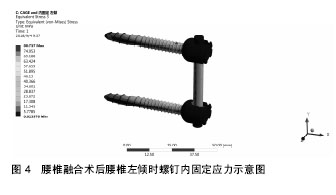
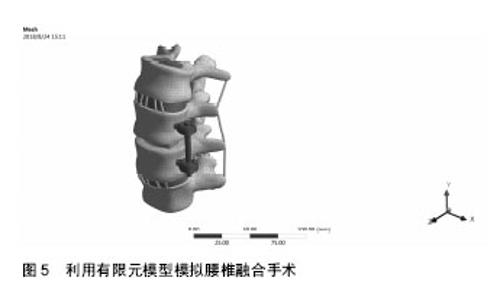
(2)腰椎内固定系统及椎间融合器的生物力学研究:在腰椎融合术中通过在椎间置入融合器,并利用椎弓根螺钉固定融合节段,是治疗退行性脊柱疾病的标准疗法,其目的是恢复腰椎的稳定性,许多学者利用有限元技术从不同角度对腰椎融合技术进行了分析,见图5。如Chen等[30]比较后外侧融合术和后路腰椎椎体间融合术发现后外侧融合术和后路腰椎椎间融合术内固定系统的最大应力都集中于螺钉的后部或螺钉与杆的连接点。在相同的骶骨倾斜角下,后外侧融合术螺钉的应力高于后路腰椎椎间融合术。后路腰椎椎间融合术可能是具有高骶骨倾斜角的更好的选择。Matsuura等[31]利用有限元技术对使用了聚甲基丙烯酸甲酯骨水泥强化的椎体进行试验,并成功预测椎体成形术前和椎体成形术后导致椎体骨折的负荷。Kumar等[32]发现,有限元模型中融合器与椎体接触的地方以及椎体的松质骨中拉伸和压缩应力较高,与正常的椎间盘相比,融合后椎体的应力模式与椎间盘退化后的应力模式相似性极高,并且发现椎间融合器改变了相邻椎体的应力分布模式。Sungchul等[33]发现,在融合器偏离原位置时,小关节载荷明显增加。这种影响在矢状面比冠状面更为明显,在矢状面时,运动变化下降10%,小关节载荷增加1%,而冠状面无明显变化。脊柱在伸展过程中的小关节应力的变化比屈曲时更明显。作者推论小关节过载似乎表明植入物排列不良,且这种情况可进一步加重小关节退变。"
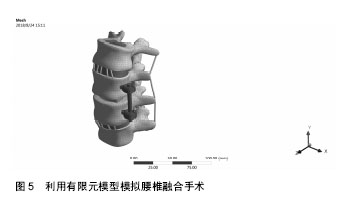

(3)腰椎融合术后融合节段对邻近节段的的应力影响:腰椎退行性疾病在进行融合术后,无论是椎体还是其他腰椎结构,其应力载荷的传递均会发生改变[34],为使融合节段达到稳定,通常使用融合器及钉棒进行内固定,将会牺牲融合节段的活动度,而邻近节段将会代偿这部分活动度,这样就会使邻近节段的间盘应力更加集中,加速了退变的过程[35-36]。也有学者经过研究发现,理想的内固定系统必须保持合理的活动范围,过度刚性的内固定系统将从融合节段向相邻节段传递过大的应力[37-38]。张生等[39]通过有限元模拟发现,进行了腰椎椎间融合术的节段以及腰椎椎间融合术并用钉棒固定的节段会加速邻近节段的退变。作者建议通过使用弹性内固定来减少邻近节段的退变。而Huang等[40]建立了整个人体的脊柱有限元模型,发现融合术后融合节段只对相邻节段间盘退变有影响,而胸腰椎融合术后对颈椎间盘退变没有影响,即融合节段对较远的间盘退变没有影响。为解决腰椎融合节段加速邻近节段退变的问题,Lee等[41]利用有限元技术分别模拟了椎弓根螺钉进行内固定的融合术后以及进行了棘突间内固定的融合术后腰椎的有限元模型,在加载相同载荷时,椎弓根螺钉组应力明显高于棘突间固定组,若2组融合术后腰椎能达到相同的稳定性,将会提供一种解决融合术后邻近节段退变的新方法。而Huang等[42]则是通过建立全椎板切除的后路腰椎椎间融合术和半椎板切除的后路腰椎椎间融合术2组模型进行比较,他们得出结果,保留了后方复合体的半椎板切除腰椎融合术在腰椎前屈时,邻近节段的活动范围、椎间盘内压力、韧带受力均小于另一组,他们推论,术中保留的后方复合体在融合术后充当了后方的张力带,这种方法也可以有效的预防融合术后邻近节段退变。由此可见,有限元技术在腰椎不同融合手术方式生物力学研究方面扮演着重要的角色,应用于术前手术术式的选择及对术后生物力学的判断,并为临床医师进行生物力学的探寻提供便捷。 2.4 有限元技术在退行性腰椎疾患应用中的局限性 虽然有限元技术已被广泛应用于腰椎退行性疾患的生物力学研究,但因其自身的特性,仍存在许多局限性,在有限元建模的过程中需要不同的弹性模量,但因个体差异以及腰椎结构的复杂性,腰椎生物力学特性并不能找到统一的标准来反映[20]。且在建模过程中,选择节点,划分网格以及加载相应的载荷都是由实验者完成,在此过程中也并没有统一的标准,建好的模型与真实腰椎相比会产生误差。另外在对内植物、椎间融合器以及骨进行接触设置时,为方便进行力学研究,会进行简化,而现实中的接触更为复杂,因此会产生误差[43]。 "

| [1] Belytschko T, Kulak RF, Schultz AB, et al. Finite element stress analysis of an intervertebral disc. J Biomech. 1974;7(3): 277-285.[2] 朱磊,霍洪军.有限元分析在强直性脊柱炎后凸畸形中的应用进展[J].中国医药导报,2014,11(7):166-168.[3] 冯其金,赵玲娟,郑昆仑,等.有限元分析法在腰椎生物力学中的研究进展[J].中国中西医结合外科杂志,2018,24(2):255-258.[4] 张振军,李阳,廖振华,等.有限元法在腰椎生物力学应用中的研究进展和展望[J].生物医学工程学杂志,2016,33(6):1196-1202.[5] 苏春涛,眭承志.腰椎三维有限元生物力学分析的技术应用进展[J].中国康复医学杂志,2013,28(5):479-482.[6] 曾至力,程黎明,朱睿,等. 胸腰椎三维非线性有限元模型的建立[J].中华医学杂志, 2011, 91(31): 2176-2180.[7] 赵岩,江建明,李筱贺,等.三维有限元分析脊柱中胸段(T6~8)结核经肋椎单元植入物固定的应力变化[J].中国组织工程研究,2015, 19(17):2762-2767.[8] 王端阳,奚春阳,杨辉,等.有限元分析法在腰椎生物力学研究中的应用及新进展[J].现代生物医学进展, 2015,15(9): 1794-1797.[9] 陈伯华,孙鹏, Natarajan N, 等.颈椎三维有限元模型的建立及意义[J].中国脊柱脊髓杂志,2002,12(2):105-108.[10] 陶勇,吴云乐,宗少晖,等.基于有限元分析腰椎内固定的生物力学特征[J].中国组织工程研究,2016,20(13):1932-1938.[11] Du HG,Liao SH,Jiang Z,et al.Biomechanical analysis of press extension technique on degenerative lumbar with disc herniation and staggeredfacetjoint. Saudi Pharm J. 2016; 24(3):305-311.[12] Rohlmann A, Zander T, Rao M, et al. Applying a follower load delivers realistic results for simulating standing. J Biomech. 2009;42(10):1520-1526.[13] 张慧,张军,钱秀清,等.有限元分析法在脊柱生物力学中的应用与进展[J].中国中医骨伤科杂志,2014,22(10):71-73.[14] 梁得华,鲁世保.有限元分析法在胸腰段脊柱骨折的应用进展[J].北京医学,2016,38(7):706-708.[15] Lotz JC,Colliou OK,Chin JR,et al. Compression-induced degeneration of the intervertebral disc : an in vivo mouse model and finite-element study. Spine. 1998;23(23): 2493-2506.[16] El-Rich M,Arnoux PJ,Wagnac E,et al.Finite element investigation of the loading rate effect on the spinal load-sharing chanes under impact conditions.J Biomech. 2009;42(9):1252-1262.[17] Little JP, Adam CJ, Evans JH, et al. Nonlinear finite element analysis of anular lesions in the L4/5 intervertebral disc. J Biomech. 2007;40(12):2744-2751.[18] Yin N, Xu G, Zhang S, et al. Finite element modeling and analyzing for lumbar muscle electrical activity. COMPEL. 2014; 33(1/2): 106-115.[19] Kim YE, Choi HW. Effect of disc degeneration on the muscle recruitment pattern in upright posture: a computational analysisEffect of disc degeneration on the muscle recruitment pattern in upright posture: a computational analysis. Comput Methods Biomech Biomed Engin. 2014; 15: 1-10.[20] 魏兵,许泽川,常山.有限元法分析腰椎椎弓根螺钉的生物力学特征[J].中国组织工程研究,2018,22(19):3091-3096.[21] 闫家智,吴志宏,汪学松, 等. 腰椎间盘退变后应力变化的有限元分析[J]. 中国医学科学院学报,2009,31(4):464-467.[22] 黄菊英,李海云,吴浩. 腰椎间盘突出症力学特征的仿真计算方法[J].医用生物力学, 2012, 27(1): 96-101[23] Dou H, Tang S. Analysis of the influence of nucleotomy on lumbar degeneration of the operated level using the finite elementmethod.Turk Neurosurg. 2014;24(2): 184-189[24] Salo G, Caceres E, Lacroix D, et al.The effect of end-plate preparation in circumferential arthrodesis of the lumbar spine. a finite element analysis. J Biomech. 2006;SUPP1: 157.[25] Costi J, Stanley R, Smith L, et al. The effect of intervertebral disc degeneration on vertebral cortical strains and disc mechanical properties. J Biomech. 2009;91-B: 435. [26] 王健,朱立新,曹延林.人体腰椎有限元建模及内固定的生物力学研究[J].中华创伤骨科杂志, 2011,13(6):589-591.[27] 张美超,肖进,李义凯,等 .腰椎小关节接触模型的有限元分析[J].第一军医大学学报,2002,22(9):836-838.[28] Cahill PJ, Wang W, Asghar J, et al. The use of a transition rod may prevent proximal junctional kyphosis in the thoracic spine after scoliosis surgery: a finite element analysis. Spine. 2012; 37(12):687-695.[29] Silve MJ, Kearveny TM, Hayes WC. Loading sharing between the shell and centrum in the lumber vertebral body. Spine. 1997;22(2): 140-150.[30] Chen L, Feng Y, Che CQ, et al. Influence of sacral slope on the loading of pedicle screws in postoperative L5/S1 isthmic spondylolisthesis patient: a finite element analysis. Spine. 2016;41(23):E1388.[31] Matsuura Y, Giambini H, Ogawa Y, et al. Specimen-specific nonlinear finite element modeling to predict vertebrae fracture loads after vertebroplasty. Spine. 2014; 39(22):1291-1296.[32] Kumar SN, Meakin JR, Mulholland RC, et al. Analysis of stress distribution in the vertebral bodies using finite element analysis. Orthop Proceedings. 2002;84-B: 140. [33] Sungchul J, Chunkun P, Kwonyong L, et al. Effects of malalignment of total disc replacement on kinematics and load-sharing characteristics of the lumbar spine. Spine. 2010.[34] Rihn JA, Lawrence J, Gates C, et al. Adjacent segment disease after cervical spine fusion. Instr Course Lect. 2009; 58:747-756.[35] 张生,祁学强,常建琪.腰椎不同融合方式对邻近节段影响的三维有限元分析[J]. 延安大学学报(医学科学版),2017,15(4):39-42.[36] Yamasaki K, Hoshino M, Omori K, et al. Risk factors of adjacent segment disease after transforaminal inter-body fusion for degenerative lumbar disease. Spine. 2017;42(2): E86.[37] Chien CY, Kuo YJ, Lin SC, et al. Kinematic and mechanical comparisons of lumbar hybrid fixation using dynesys and cosmic systems. Spine (Phila Pa 1976). 2014;39:E878-E884.[38] Chuang WH, Lin SC, Chen SH, et al. Biomechanical effects of disc degeneration and hybrid fixation on the transition and adjacent lumbar segments: trade-off between junctional problem, motion preservation, and load protection. Spine (Phila Pa 1976). 2012;37:E1488-E1497.[39] 张生,祁学强,常建琪.腰椎不同融合方式对邻近节段影响的三维有限元分析[J].延安大学学报(医学科学版),2017,15(4): 39-42+97.[40] Huang H, Nightingale RW, Dang A. Biomechanics of coupled motion in the cervical spine during simulated whiplash in patients with pre-existing cervical or lumbar spinal fusion:A Finite Element Study. Bone Joint Res. 2018;7(1):28-35.[41] Lee CH, Kim YE, Lee HJ, et al. Biomechanical effects of hybrid stabilization on the risk of proximal adjacent-segment degeneration following lumbar spinal fusion using an interspinous device or a pedicle screw-based dynamic fixator. J Neurosurg Spine. 2017;27(6):643-649.[42] Huang YP, Du CF, Cheng CK, et al. Preserving posterior complex can prevent adjacent segment disease following posterior lumbar interbody fusion surgeries: a finite element analysis. Plos One. 2017;12(2):e0172329.[43] Chun DH , Yoon DH , Kim KN, et al. Biomechanical comparison of four different atlantoaxial posterior fixation constructs in adults. Spine (Phila Pa 1976). 2018;43(15): E891-E897. |
| [1] | Xu Feng, Kang Hui, Wei Tanjun, Xi Jintao. Biomechanical analysis of different fixation methods of pedicle screws for thoracolumbar fracture [J]. Chinese Journal of Tissue Engineering Research, 2021, 25(9): 1313-1317. |
| [2] | Jiang Yong, Luo Yi, Ding Yongli, Zhou Yong, Min Li, Tang Fan, Zhang Wenli, Duan Hong, Tu Chongqi. Von Mises stress on the influence of pelvic stability by precise sacral resection and clinical validation [J]. Chinese Journal of Tissue Engineering Research, 2021, 25(9): 1318-1323. |
| [3] | Chen Xinmin, Li Wenbiao, Xiong Kaikai, Xiong Xiaoyan, Zheng Liqin, Li Musheng, Zheng Yongze, Lin Ziling. Type A3.3 femoral intertrochanteric fracture with augmented proximal femoral nail anti-rotation in the elderly: finite element analysis of the optimal amount of bone cement [J]. Chinese Journal of Tissue Engineering Research, 2021, 25(9): 1404-1409. |
| [4] | Zhou Jihui, Li Xinzhi, Zhou You, Huang Wei, Chen Wenyao. Multiple problems in the selection of implants for patellar fracture [J]. Chinese Journal of Tissue Engineering Research, 2021, 25(9): 1440-1445. |
| [5] | Pei Lili, Sun Guicai, Wang Di. Salvianolic acid B inhibits oxidative damage of bone marrow mesenchymal stem cells and promotes differentiation into cardiomyocytes [J]. Chinese Journal of Tissue Engineering Research, 2021, 25(7): 1032-1036. |
| [6] | Xu Yulin, Shen Shi, Zhuo Naiqiang, Yang Huilin, Yang Chao, Li Yang, Zhao Heng, Zhao Lu. Biomechanical comparison of three different plate fixation methods for acetabular posterior column fractures in standing and sitting positions [J]. Chinese Journal of Tissue Engineering Research, 2021, 25(6): 826-830. |
| [7] | Cai Qunbin, Zou Xia, Hu Jiantao, Chen Xinmin, Zheng Liqin, Huang Peizhen, Lin Ziling, Jiang Ziwei. Relationship between tip-apex distance and stability of intertrochanteric femoral fractures with proximal femoral anti-rotation nail: a finite element analysis [J]. Chinese Journal of Tissue Engineering Research, 2021, 25(6): 831-836. |
| [8] | Yang Weiqiang, Ding Tong, Yang Weike, Jiang Zhengang. Combined variable stress plate internal fixation affects changes of bone histiocyte function and bone mineral density at the fractured end of goat femur [J]. Chinese Journal of Tissue Engineering Research, 2021, 25(6): 890-894. |
| [9] | Song Chengjie, Chang Hengrui, Shi Mingxin, Meng Xianzhong. Research progress in biomechanical stability of lateral lumbar interbody fusion [J]. Chinese Journal of Tissue Engineering Research, 2021, 25(6): 923-928. |
| [10] | Liu Zhao, Xu Xilin, Shen Yiwei, Zhang Xiaofeng, Lü Hang, Zhao Jun, Wang Zhengchun, Liu Xuzhuo, Wang Haitao. Guiding role and prospect of staging and classification combined collapse prediction method for osteonecrosis of femoral head [J]. Chinese Journal of Tissue Engineering Research, 2021, 25(6): 929-934. |
| [11] | Xie Chongxin, Zhang Lei. Comparison of knee degeneration after anterior cruciate ligament reconstruction with or without remnant preservation [J]. Chinese Journal of Tissue Engineering Research, 2021, 25(5): 735-740. |
| [12] | Liu Bo, Chen Xianghe, Yang Kang, Yu Huilin, Lu Pengcheng. Mechanism of DNA methylation in exercise intervention for osteoporosis [J]. Chinese Journal of Tissue Engineering Research, 2021, 25(5): 791-797. |
| [13] | Zhang Guomei, Zhu Jun, Hu Yang, Jiao Hongwei. Stress of three-dimensional finite element models of E-MAX porcelain inlay [J]. Chinese Journal of Tissue Engineering Research, 2021, 25(4): 537-541. |
| [14] | Nie Shaobo, Li Jiantao, Sun Jien, Zhao Zhe, Zhao Yanpeng, Zhang Licheng, Tang Peifu. Mechanical stability of medial support nail in treatment of severe osteoporotic intertrochanteric fracture [J]. Chinese Journal of Tissue Engineering Research, 2021, 25(3): 329-333. |
| [15] | Tan Jiachang, Yuan Zhenchao, Wu Zhenjie, Liu Bin, Zhao Jinmin. Biomechanical analysis of elastic nail combined with end caps and wire fixation for long oblique femoral shaft fractures [J]. Chinese Journal of Tissue Engineering Research, 2021, 25(3): 334-338. |
| Viewed | ||||||
|
Full text |
|
|||||
|
Abstract |
|
|||||